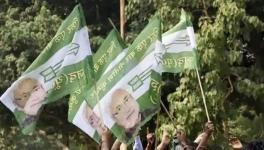Litchi Farmers in Muzaffarpur Hit by Alleged Litchi-AES Link
Image for representational use only.Image Courtesy : The Financial Express
Muzaffarpur: Usually by the end of June, Sashiranjan Kumar, a litchi-growing farmer in Bihar’s Muzaffarpur, expects to be happy after a bumper harvest and good income.
But this year, he is neither happy nor did he get even a half-decent profit from his farming of litchi, the seasonal summer fruit — thanks to misinformation that litchi is the ‘main’ reason behind the deaths of 132 children due to Acute Encephalitis Syndrome (AES). This is even as several medical experts have pointed out that it is malnutrition that is the key culprit in this case and litchi is only a trigger. Added to this is Bihar’s crumbling public health infrastructure and services. It may be noted that three-fourth of the children who died belonged to below poverty line (BPL) families, as reported by Times of India, citing a survey.
However, the onslaught of the disease has directly hit Muzaffarpur’s booming litchi business as traders, mostly from outside Bihar, have either refused to purchase the fruit or have forced distress sale of the fruit on the pretext of its alleged link with AES.
“The misinformation and rumours that litchi is causing deaths of children in Muzaffarpur has affected me, just like other litchi-growing farmers, rather badly. There was no trader ready to purchase litchis from my big orchard with more than 400 litchi trees. I decided not to pluck ripened litchis and left them to dry and rot,” said Sashiranjan, a litchi farmer at Kalwari village under Kanti block of Muzaffarpur.
He told NewsClick that he personally has suffered a loss of Rs 5 to 6 lakh due to these ‘rumours’.
Sashiranjan is one among the thousands of farmers who have been forced to sell their produce at much lower prices during peak season when the AES outbreak happened — as the fruit is highly perishable, if not kept in a high-tech storage facility.
According to a report by the horticulture department, there are 45,000 litchi-growing farmers in Muzaffarpur.
Dismissing reports linking litchi with AES, Bholanath Jha, a farmer said AES has nothing to do with the fruit.
“Muzaffarpur’s litchi has been defamed by some vested interests,” he alleged, claiming that “no scientific research has so far linked litchi with AES outbreak.”
Also read: Bihar: Encephalitis Victims’ Fathers, Kin Booked for Demanding Clean Water, Health Facilities
Bachcha Singh, president of Litchi Utpadak Sangh, told NewsClick, “It is completely wrong to have singled out litchi for AES. Litchi farmers have been affected as demand of litchi has drastically dropped from outside. The concerned departments of the Centre and the state government should do something to dispel the misinformation.”
He said, “We were informed by doctors that AES cases were being reported since February, when litchi trees had just started flowering. Besides, what about the children aged between 6 to 10 months, who died? Had they eaten litchis?”
Dr Nishandra Kienzalk, a medical practitioner in Muzaffarpur, also rued that the district’s “sweet and juicy” litchis were being defamed by some people. “The fact is that several studies and clinical researches have made it clear that AES is not caused by litchi,” he said, adding that, “AES is caused mainly by malnutrition and other factors during summers."
The Muzaffarpur-based National Research Centre on Litchi's Director Vihal Nath also reiterated that there was “no scientific connection between the disease and the fruit.”
He said, “I fail to understand how and why litchi, a nutritious fruit, is being defamed and blamed for AES. We have carried out studies at our centre, but there is no clinching evidence that litchi is the monster, causing the deaths of children. This misinformation is doing irreparable damage to litchis.”
For thousands of farmers, growing litchis is the primary source of livelihood. “Muzafffarpur’s shahi (royal) litchi is famous for its big size, unique flavour, aroma and taste. It is not found anywhere else. It is unique,” he said.
Another expert, S Pandey also said that it was misleading to blame litchis for AES. “Litchi is not grown only in Muzaffarpur and it is not a new fruit. It is also far from truth that children eat unripe litchis,” he added.
Meanwhile, Dr Gopal Shankar Sahni, head of paediatrics at state-run Sri Krishna Medical College & Hospital (SKMCH) in Muzaffarpur, where 111 children died as per the official count, however, said a medical research team was examining the effects of litchis on AES-afflicted children.
The Bihar health department has also put litchis under medical investigation following its alleged link to AES.
Also read: Why Modi’s Ayushman Bharat Collapsed in Bihar as AES Continues to Kill Children
Bihar Agriculture Minister Prem Kumar last week said a team of agricultural scientists and horticulture officials would probe whether litchi was ‘responsible’ for AES or if there was any role that litchis played in the deaths of children suffering from AES. He said only an investigation would end the “speculation, misconceptions and fears” about consumption of the fruit. He did not rule out a “conspiracy to defame litchi grown in Bihar.”
Bihar’s Muzaffarpur district — known as the ‘land of litchis’ — along with its neighbouring districts, accounts for more than 62% of the country’s litchi production, down from 70% earlier.
Doctors and health officials have differing views on the reasons behind the outbreak of AES and the cause of the deaths of children. This has further complicated the process of combating or controlling the seasonal outbreak of AES in northern Bihar.
None other than state Chief Secretary Deepak Kumar publicly admitted that even the government was unclear about what exactly was causing the AES outbreak, which has been recorded in Muzaffarpur since 1995.
“We are still not aware if the disease is caused due to some virus, bacteria, malnourishment, some toxic effect due to consumption of litchi or due to environmental conditions such as high temperature and humidity. Several researches have been done, including by a team of experts from the Centre for Disease Control, Atlanta, but the findings are inconclusive,” he said.
Get the latest reports & analysis with people's perspective on Protests, movements & deep analytical videos, discussions of the current affairs in your Telegram app. Subscribe to NewsClick's Telegram channel & get Real-Time updates on stories, as they get published on our website.























